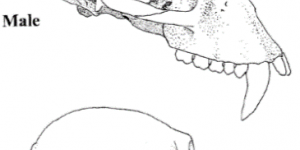Although prostitution was a ubiquitous institution, which thrived across the Mediterranean region, this report focuses on its existence in ancient Rome. Using books and journal articles written by scholars J.A Baird, Ray Laurence, Thomas McGinn, and Anise Strong as a guide, one can examine prostitution through the lenses of several literary sources, as well as through art, building remnants and reconstructed maps. This report has three distinct objectives: first, it outlines the ways in which Roman literary sources discussed prostitution and considers what this indicates about its social implications; secondly, specific locales in which prostitution was conducted are introduced with attention to the character of each; and finally, the debate on moral zoning is explored.
Ancient texts from Roman authors offer strong opinions on prostitution. This is illustrated by the famous translation of Cato the Younger’s quote regarding two young men he saw exiting from a brothel: “Blessed be they as virtuous, who when they feel their virile members swollen with lust, visit a brothel rather than grind at some husband's private mill” (Horace, Satires, 1.1). This supports the argument that Ray Laurence proposes with respect to social implications: engaging a prostitute was not considered disgraceful for a man. In fact, he notes that prostitution was seen as a means to preserve a family’s wellbeing, an appropriate sexual outlet for men whose wives “would die from repeated child bearing” (Roman Pompeii: Space and Society, 84) if the pair had more frequent sexual relations. To this end, prostitution was considered legal and was a legitimate source of income during the imperial period, as women were registered by an aedile if their income was earned solely through prostitution and they were subsequently taxed.
Though the act was condoned for men, the prostitute herself was shamed. Martial’s description of a prostitute as “a girl of none too good a reputation, such as those that sit in the middle of Subura” (Epigrams, 6.66) reinforces the view that the prostitute was a meretrix, in direct opposition to a Roman matron (matrona). According to Lawrence, she wore a short, brightly coloured dress and elaborate hairstyle and makeup that made her immediately distinguishable, possibly enforced by a dress code introduced in the Augustinian Adultery Law (Roman Pompeii: Space and Society, 86). However, it is interesting to note that the relationship between matrons and prostitutes was not hostile by any means. Anise Strong writes: “While meretrices certainly did not share the same social status or respect as married women, they formed a ubiquitous part of the urban landscape… Not only men but matronae view and are viewed by meretrices; this gaze is not morally corrupting for the matron, nor does it humiliate the prostitute” (Prostitutes and Matrons in the Roman World, 142-143). The lenones were on the other side of the profession, “pimps” who facilitated prostitution as either a main or side business.
Much of what is known about prostitution in ancient Rome comes from reading literary sources, but interpreting archaeological finds is just as crucial in the consideration of theories promoted in literature, as well as to consider new ones. Goals for archaeologists include formulating a picture to accurately characterise the locales in which prostitution took place, while devising the standards upon which their conclusions are based. McGinn outlines Wallace Hadrill’s criteria as an example: “1) the structural evidence of a masonry bed set in a small cell of ready access to the public… 2) the presence of paintings of explicit sexual scenes…3) the cluster of [erotic] graffiti” (Pompeian Brothels and Social History, 8). However, these yardsticks are particularly limiting and may restrict prostitution to sites only identified as cellae and lupanar. Cellae were considered “cribs”; single rooms opening onto back alleyways or attached to taverns and houses. A single prostitute worked out of them and they often had lamps placed outside as a calling sign to those who were in the know. The lupanar was the permanent brothel, a site which allowed two or more prostitutes to work simultaneously, and where sex was the primary business. There is only one structure definitely identified as a Roman lupanar, the Purpose-Built Brothel in Pompeii. Located on a winding street not far from the Forum, the brothel possessed a corridor opening to five rooms, each with a masonry bed and erotic paintings above its doorway. There were five additional rooms on a second floor, postulated to perhaps function as sleeping quarters for the prostitutes employed there. With over a hundred examples of erotic graffiti visible, including prices for sexual acts, this space offers the clearest data on Roman brothels, but by no means can one conclude that it was the largest or busiest location in which prostitution occurred.
One aspect is overlooked by this characterization – namely, prostitution did not always require a specialized building or bed, as can be gleaned from texts and graffiti that illustrate a range of locations for potential sexual transactions, including baths, graveyards, and even Forums. As McGinn notes, popinae (bars), and cauponae (inns) were likely very popular convenient sites for men to solicit prostitution as well (Pompeian Brothels and Social History, 1112). Wooden beds that have not survived are suspected to have been used in many places, further broadening the variety of locations available. Additionally, erotic art and graffiti have been discovered in many spaces and may suggest a prevalence of sexual behaviour, including paid, that occurred in places with no other signs to indicate the location was a site limited to just prostitution on its own.
Because the stringency of this characterization varies among them, modern scholars have different estimates of how many places of prostitution existed in cities, shaping a debate on whether these spaces were purposefully secluded in an ancient version of a “red-light district.” Laurence is a strong proponent for a historical effort toward moral zoning in Pompeii, as he argues that the seven possible brothels in the city (based on stricter criteria) tended to be located apart from areas typically frequented by women and children and near places of stereotypically masculine activities. In effect, the city population would not have come into contact with prostitution unless it was sought out (Roman Pompeii: Space and Society, 92). Strong and McGinn oppose this theory, citing a broader range of venues within which prostitution could occur, such as houses and public places, that undermine segregated prostitution districts (Pompeian Brothels and Social History, 26). McGinn also contends that some of the textual evidence used in favor of moral zoning come from a post-Christianization perspective of the Roman empire, and thus prioritize Christian, rather than inherently Roman views of behavioural standards (Economy of Prostitution in the Roman World, 93).
An examination of the attitudes towards the act of prostitution and its areas in Roman culture are particularly revealing in that they demonstrate the possibility of no segregation between “honourable” and “dishonourable” women in terms of public space. The evidence supporting the likelihood that men solicited prostitutes in public places illustrates that the transaction seems to have been accepted to some degree as a fact of life, and not necessarily deemed immoral as it is in the current era. The debate over moral zoning further reflects a modern stigmatization of prostitution and highlights how the evolution of attitudes over time might have coloured scholarship. Given the variety of sources available, an analysis of all evidence is crucial to most accurately reconstruct Roman positions regarding not just prostitution but also broader analyses in regard to gender and sexuality, as ancient perspectives may have differed greatly from our own.
Bibliography
Primary Sources:
-
Horace. Satires Book I. Translated by H. R. Fairclough. Cambridge: Harvard University Press, 1926, 1.1. https://www.loebclassics.com/view/LCL194/1926/volume.xml (accessed March 13, 2017).
-
Martial. Epigrams. Translated by D. R. Shackleton Bailey. Cambridge: Harvard University Press, 1993, 6.66. https://www.loebclassics.com/view/LCL094/1993/volume.xml (accessed March 13, 2017).
Secondary Sources:
-
Baird, J.A. Epigrams. “On Reading the Material Culture of Ancient Sexual Labor.” Helios Vol. 42, No. 1 (2015): 163–175. Accessed March 6, 2017. doi:10.1353/hel.2015.0001.
-
Laurence, Ray. Roman Pompeii: Space and Society. New York: Routledge, 2007.
-
McGinn, Thomas. Economy of Prostitution in the Roman World. Ann Arbor: University of Michigan Press, 2004.
-
McGinn, Thomas. “Pompeian Brothels and Social History.” Journal of Roman Archeology (2002): 7-46. Accessed March 6, 2017.
-
Strong, Anise K. Prostitutes and Matrons in the Roman World. New York: Cambridge University Press, 2016.





